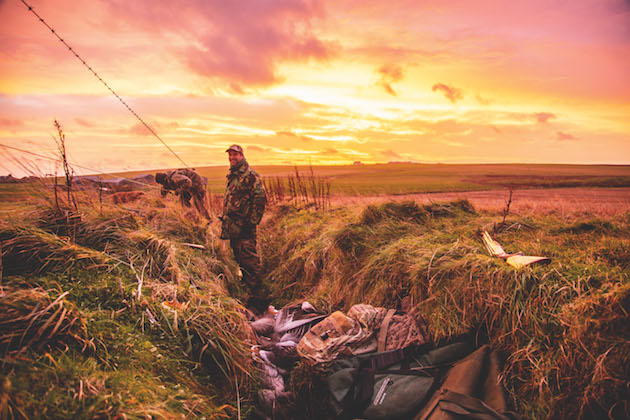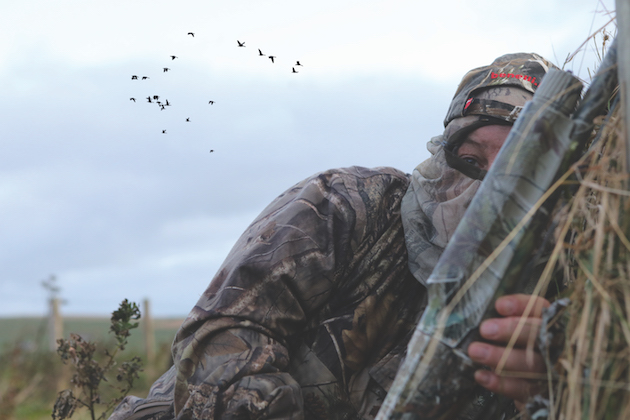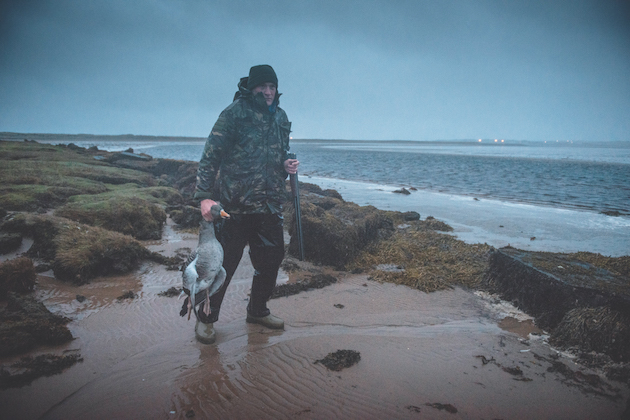Gun buying guide: Wildfowling
Bill Elderkin selects three of the best guns for wildfowling this winter.
Win CENS ProFlex DX5 earplugs worth £1,149 – enter here
 Ollie Carr & Raymond Shearer picking up Geese after a successful mornings shooting
Ollie Carr & Raymond Shearer picking up Geese after a successful mornings shooting
A couple of years ago, on a rather grey October afternoon, I was trudging around Stornoway on the Isle of Lewis with my good friend Will Martin, looking for the local goose guru. After knocking on a few wrong doors, we found him. Despite a bottle of Scotch as a peace offering, he looked at us rather suspiciously, gave us only a whisper of his knowledge then closed the door.
Disheartened, we went to fill up the car at Engebret’s, a petrol station-cum-gun dealer (perhaps the only place in the country you can get a full tank and a slab of cartridges). The £30 we spent on fuel and pick’n’mix led to a far more productive conversation than the one we’d had earlier, and after half an hour of talking geese with Engebret’s owner, we had gathered vital intelligence about the best spots around Stornoway.
Despite studying animal behaviour at university, the behaviour of geese remains a bit of a mystery to me. I’m sure there are wildfowlers out there who could major on the flight lines, grazing and roosting patterns of geese, and I take my hat off to them. My experiences to date have depended on guess work, little snippets of local knowledge, and a large dose of luck.
In Stornoway, the geese graze on the grassland around the estuary during the day. Then, when it gets too dark to see any predators coming, they fly out and roost in the middle of the estuary. But pinpointing them was difficult. It often felt like we were trying to crack a code and unearth the secrets of their movements, using any morsel of information and plotting at length the night before a morning flight, trying to decipher the pattern.
Over the course of a week in Stornoway, we managed to shoot 26 geese between four of us, all of them plucked on the island and taken back to the mainland where they kept us fed for weeks. It was amazingly good fun but there were a few mornings we retreated for a coffee with nothing to show for our early start except cold toes, cursing the geese that had once again chosen a flight path different from the one we thought they’d choose. These failures were followed with more recons and often another fruitless attempt.
Last year I was invited to go and shoot pink-feet geese in north-east Scotland. It was going to be a trip with five flights over three days and the price was £600. Talking it through with Alex, the organiser, he seemed convinced by the hassle-free nature of the shooting and the high chance of some good sport (always tricky with wild birds). Part of me felt that £600 was a lot to spend when I knew I could shoot them elsewhere for nothing. As it happened, the dates didn’t work and I wasn’t able to go. However, the reports that came back from the trip were of some top-quality goose shooting and that it was worth every penny.

It is important that a guide doesn’t take people to the same areas repeatedly or birds will get wise
Perhaps Alex had a point; goose shooting does not have to be hard work if you don’t want it to be or if you simply don’t have the time to undertake the research. I decided to put my parsimonious nature to one side and investigated some options. My focus was Scotland, but there are numerous places across Britain that are plagued by geese, notably East Anglia. It does not take too long on Google to find plenty of opportunities. I came across an advert for goose shooting in Scotland, close to where I was going to be on another trip; it looked like the kind of thing I was after and I put in a call to Matthew Hollington at Atlas Sporting.
Matthew was incredibly helpful and I could see the benefit of going through someone in the know immediately. He explained that he had started small and grown the business through building a good network of farmers and wildfowlers, and working in partnership with them to achieve their goals. It had started with Matthew and a group of friends from college traipsing up and down the Scottish coast knocking on the doors of farmers, offering their goose control services.
For the farmers, especially the smaller ones, a large flock of geese can decimate crops so quickly that in a matter of days the farmers can, in some cases, lose an entire harvest. The farmers therefore need the geese to be controlled and kept off their crops. Interestingly, it seems that control rather than cull appears to be the mantra; most are not keen to see the local population gone, but simply a tempering of the vast numbers that can so easily destroy a livelihood.

Those who have only shot pheasants and partridges often find wildfowling enriching
It seems that one of the main advantages for farmers advertising their fields for goose shooting through a sporting agent is that it regularises the shooting, and a more concerted effort can be made in the control of geese numbers, not just the occasional university student.
Matthew also explained the importance of a local network of keen and knowledgeable wildfowlers, who could recce areas and who had a good understanding of goose behaviour. For instance, knowing that if a flock of geese leaves a field half eaten one evening, they’re likely to come back to that field the following morning. It also takes time and effort to scan the coastline the evening before a morning flight to try and find the geese or that half-eaten field.
I have often been pigeon shooting on our family farm, with a few pigeon decoys plonked sporadically across a field. I tend to shoot a handful but never the mega bags you sometimes hear of. I’m sure there is actually a great deal of skill in setting out the decoy pattern and this is the same for geese. When a big skein comes across, you have hundreds of eyes spying down on the ground below. If one goose notices something it doesn’t like, the chances are the skein will fly on to another spot. So the art of laying out a good goose decoy pattern and making it as attractive as possible for wild geese to come in is key.
By the end of the conversation with Matthew, I had booked in a morning flight in November and handed over £150. Whilst it may sound a lot for a bit of goose shooting, to me it now sounded fair when you take into account all the work that has to be done. If I had more time, I could perhaps spend a couple of days knocking on doors and trying to work out where the geese are. Matthew explained that an expected bag would be between 30 and 50 geese in one flight, and that if that was an equivalent pheasant day, you would be paying a lot more than £150.
By going through a sporting agent or local goose guide, the hassle is removed completely. All that a gun needs to consider is getting to the grounds and where they’re going to have their pint that evening.
Bill Elderkin selects three of the best guns for wildfowling this winter.
But are there rogue goose guides out there? Of course there are and lots of people have had experiences of handing over a wad of cash only to be left feeling that they are maybe being led on a bit of a wild goose chase. You might not have the time to do three days of recon but you probably do have a few hours to speak to friends and ring round gun shops in the area in order to find out if someone really is able to produce the goods.
I am looking forward to November immensely. Perhaps my only concern is that the sense of adventure and the satisfaction of cracking the code will be lost, but time will tell. Having spent so many mornings on the cold, dark, windy and wet Scottish foreshore without seeing or even hearing a goose, it feels like a luxury to be going somewhere with a much better chance of finding some sport.
Get the latest news delivered direct to your door
Discover the ultimate companion for field sports enthusiasts with Shooting Times & Country Magazine, the UK’s leading weekly publication that has been at the forefront of shooting culture since 1882. Subscribers gain access to expert tips, comprehensive gear reviews, seasonal advice and a vibrant community of like-minded shooters.
Save on shop price when you subscribe with weekly issues featuring in-depth articles on gundog training, exclusive member offers and access to the digital back issue library. A Shooting Times & Country subscription is more than a magazine, don’t just read about the countryside; immerse yourself in its most authoritative and engaging publication.

